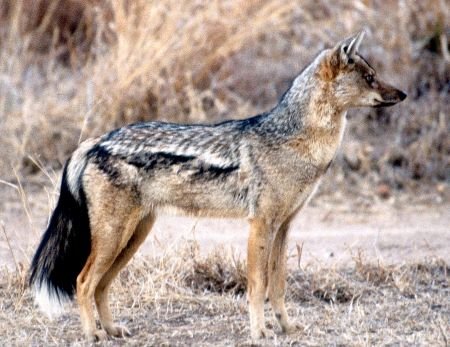
The side-striped jackal is one of those animals that can slip under the radar. Often overshadowed by its more famous relatives like the golden jackal, this species has unique traits and behaviors. But despite being relatively adaptable, their populations are dwindling in certain areas due to habitat loss and human activities. So, let’s dive deeper into the current status of the side-striped jackal and explore what global efforts are underway to conserve this intriguing animal.
What is the Side-Striped Jackal?
The side-striped jackal (Canis adustus) is a medium-sized member of the Canidae family, which includes dogs, wolves, and foxes. These jackals have a distinctive appearance—long legs, a narrow snout, and a bushy tail, all wrapped up in a coat of grayish-tan fur with a striking black stripe running along their sides. You might spot them trotting gracefully through grasslands, savannas, or even forests in Central and Southern Africa.
What makes side-striped jackals particularly fascinating is their behavior. They are more social than many other jackal species and often live in small family groups. They’re not picky eaters either; their diet consists of small mammals, insects, and even fruits. Think of them as the recyclers of their habitat, helping to maintain a balance in the ecosystem by keeping certain animal populations in check.
Current Conservation Status
So, are side-striped jackals endangered? The short answer is—it depends. According to the International Union for Conservation of Nature (IUCN), they are classified as Least Concern, meaning they are not currently at immediate risk of extinction. However, the situation varies by region. In parts of South Africa and other areas, their numbers are declining due to habitat destruction and increasing human encroachment.
Even though they aren’t facing extinction right now, local populations may struggle. You might be surprised to know that habitat loss is one of the biggest threats. As forests and grasslands get transformed into farmland or urban areas, these jackals lose their homes and hunting grounds. Honestly, that’s a tough break for a species trying to survive in a rapidly changing world.
Threats to the Side-Striped Jackal
Understanding the threats to the side-striped jackal is crucial for conservation efforts. Here are some of the main challenges they face:
- Habitat Loss: As mentioned, the conversion of land for agriculture and urban development reduces the available habitats for these jackals.
- Human-Wildlife Conflict: When jackals venture into human settlements in search of food, they can be seen as pests, leading to persecution.
- Road Mortality: Jackals often cross roads, and unfortunately, many end up as roadkill, further decreasing their populations.
- Poaching: In some regions, these jackals may be hunted for their fur or out of fear, contributing to their decline.
These challenges paint a concerning picture for the side-striped jackal’s future. You might be wondering, what can be done about it? Thankfully, conservationists are on the case!
Conservation Efforts Around the World
Globally, efforts are underway to protect the side-striped jackal and ensure their populations remain stable. Conservation organizations are focusing on several key areas:
- Protected Areas: Many regions are designating lands as protected areas, where jackals can thrive without the pressures of development and hunting.
- Community Education: By teaching local communities about the role of jackals in the ecosystem, conservationists aim to reduce fear and promote coexistence.
- Monitoring Populations: Researchers are conducting studies to better understand the population dynamics and health of side-striped jackals, which helps guide conservation strategies.
Imagine the sense of community when villagers realize that supporting wildlife can lead to healthier ecosystems and even benefits their farming practices. It’s a win-win!
The Importance of Biodiversity
You might be wondering why the conservation of side-striped jackals matters. Well, their existence contributes to biodiversity, which is crucial for a healthy planet. Each species, no matter how small, plays a role in its ecosystem. For example, by controlling the populations of small mammals and insects, the side-striped jackal helps maintain a balance that benefits plants and other animal species.
Biodiversity also ensures that ecosystems can withstand changes, like climate shifts or human encroachment. Protecting species like the side-striped jackal is like having a backup plan for nature; it’s a safeguard against potential disasters.
Local Engagement and Global Action
Local communities play a significant role in the conservation of the side-striped jackal. Efforts that involve community members are often more successful than those that don’t. When people feel included in conservation efforts, they’re more likely to care about the outcomes.
Here are some ways local engagement is making a difference:
- Eco-Tourism: Some communities are embracing eco-tourism, allowing visitors to appreciate local wildlife and generating income through conservation efforts.
- Wildlife Sanctuaries: Establishing sanctuaries that involve local people can foster a sense of pride and responsibility towards the side-striped jackals.
- Participatory Monitoring: Engaging locals in monitoring wildlife can enhance data collection while providing education about the importance of these animals.
This collaborative approach creates a symbiotic relationship between humans and wildlife, boosting conservation success while benefiting communities.
The side-striped jackal may not be sitting at the top of everyone’s conservation list, but that doesn’t mean they aren’t worth our attention. They play an essential role in their ecosystems, and understanding their challenges helps us appreciate the bigger picture of biodiversity and conservation.
With ongoing efforts and increased awareness, there’s hope for these clever canines. By supporting conservation initiatives and engaging local communities, we can foster a brighter future for the side-striped jackal. So, the next time you hear about this remarkable species, you’ll know their story—and why it matters. Just like a delightful cup of coffee, every part of our ecosystem has its flavor, and we must work together to keep it brewing strong!
